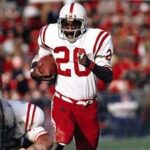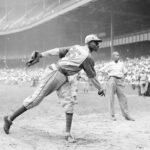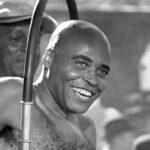A Reversal in Tennis Fortunes in 2009 as Federer Vs. Nadal on Clay

Roger Federer wins the 2009 final at the ATP Madrid Open against Rafael Nadal.
2009 did not begin well for the man from Switzerland, Roger Federer. He made headlines after the Australian Open––not because he won––but because he cried a river after his loss. As did his fans.
He did everything better than Rafael Nadal except win the big points when it mattered, losing 5-7, 6-3, 6-7, 6-3, 2-6. His tears were out of frustration and anger at himself when he felt the match should have been his.
Understandably Federer started the year under pressure––recovering from a back injury suffered in the waning months of 2008. In the early moments of 2009, the World No. 2 lost in the semifinals at Abu Dhabi to Andy Murray. Then he lost again to Murray in the semifinals at Doha. Finally he captured a win in the finals over Stanislav Wawrinka at the exhibition in Kooyong just prior to the Australian Open.
During the lead-up matches to the finals at the 2009 Australian Open, Federer played well enough. He defeated his early opponents in straight sets. In the 4th round he came back from two sets down to defeat Tomas Berdych in five sets. Then he took out both Juan Martin del Potro and Andy Roddick, respectively in the quarterfinals and semifinals to reach the championship match where Nadal awaited.
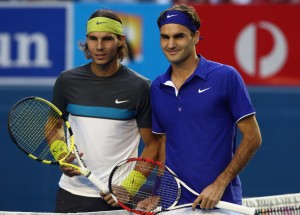
Rafael Nadal and Roger Federer pose at the beginning of the 2009 Australian Open final.
After he lost the Australian Open final, Federer blamed his erratic first serve for his loss; but up until the final, the Swiss maestro appeared to be hitting the ball well.
Regardless, he left Australia distraught over this lost opportunity. A win would have pulled him equal to Sampras’ record of 14 grand slam titles.
Feeling he needed additional time to heal from his back injury and as a further precaution, Federer decided to withdraw from Dubai and a much-anticipated Davis Cup tie with the United States.
Later Federer arrived in the United States for the two mandatory hard court Masters Series Tournaments. The World No. 2 played both at Indian Wells and at the Sony Ericsson Open losing in the semifinals in both tournaments. He lost to Andy Murray at Indian Wells and then to Novak Djokovic in Miami, unable to come back in the third set.
Following a forehand miss hit into the net against Djokovic, Federer, in a fit of anger, smashed his racquet. The tennis world took notice of this aberrant behavior, acknowledging the man from Switzerland was suffering some sort of crisis of confidence.
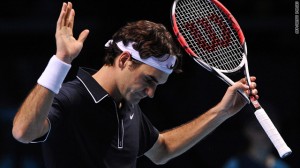
In 2009 Federer was having difficulty finding his game.
The question remained, would the man of steel find his way back in 2009? Could Federer find his game in time to salvage his sagging rankings? Other players were beginning to nip at his heels.
As Nadal was ripping up the rest of the pack and reigning supreme on European clay, Federer’s critics were front and center, once again counting him out. They implied that Federer’s best days were behind him––just as they had suggested after Federer lost to Djokovic at the Australian Open in 2008.
Federer, thoroughly disgusted with his performance on hard courts, looked ahead to clay hoping for a change in his tennis fortunes.
The Swiss asked for and received a wild card into the Monte Carlo tournament. But it did not turn out well for him as he lost in the third round to his countryman Stanislav Wawrinka. It was the first time Federer had ever lost to the Swiss No. 2.
Following Monte Carlo, Federer lost to Djokovic for the first time on clay at the tournament in Rome. It appeared that the Swiss had the lead and the momentum in this match until a rain delay interrupted play and sent the players back to the locker room.
When play resumed, Djokovic was a different player with more determination and more aggression than he had mustered earlier in the contest. Still, Federer had his chances to win this match. The Swiss remained frustrated in his inability to close out this contest, constantly allowing Djokovic back in by not holding his own serve. He lost 6-4, 3-6, 3-6.
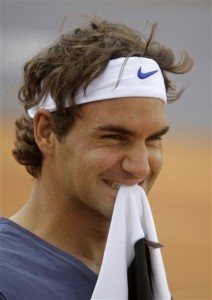
Federer began to feel his game coming together on the Madrid clay in 2009.
In Madrid, however, Federer would finally put all the fragments of his game together. He felt he was playing better and especially serving better than he had in previous weeks. Once again, the Swiss ran over del Potro on his way to the final, defeating the Argentine 6-3, 6-4 in the semifinals––improving his record to 5-0 over the lanky Argentine.
In the Madrid final facing his nemesis Nadal, Federer felt the pieces coming together as his game coalesced while Nadal’s fatigue over his four hour semifinal against Djokovic took its toll.
Federer won their contest 6-4, 6-4 and prevented Nadal once again from winning all three ATP Masters Series 1000 clay court titles in one season.
What no one realized at this point was the heights to which Federer would soar, nor the depths of Nadal’s collapse as injury began to dismantle the Spaniard’s reign at the top of the men’s game.
With the French Open on the horizon, Federer’s win in Madrid over Nadal instilled vast amounts of self-confidence back into the Federer psyche. He approached Stade Roland Garros with new-found belief in his game and his chance to win the one grand slam trophy that had eluded him all these years.
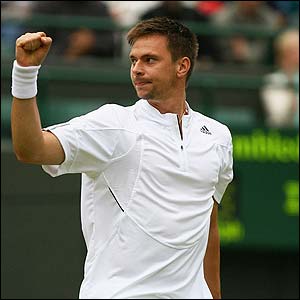
Robin Soderling defeated Rafael Nadal in the 4th round at the 2009 French Open.
Only those closest to Nadal understood the tenuous nature of the Spaniard’s health and fitness as he enter Paris to defend his crown on the red clay where he had never lost. In the fourth round, however, Nadal faced Swede Robin Soderling whose power game and aggression finally buckled the knees of the King of Clay and sent him packing back to Mallorca 6-2, 6-7, 6-4, 7-6.
Nadal, who had never lost on the grounds of Stade Roland Garros, going back to 2005, would not play another match here until 2010.
For Federer it meant that here was his greatest opportunity ever to take this championship because he would not have to face Nadal in the 2009 French Open final. But it also meant that he had to win the rest of his matches.
Finding himself down two sets to love against Tommy Haas, Federer rallied to win in five sets and advance to the quarterfinals. There he met and defeated Gael Monfils in straight sets, advancing to his 20th consecutive grand slam semifinal where he would once again meet del Potro. It took five sets to overcome the Argentine, 3-6, 7-6, 2-6, 6-1, 6-4.
At the conclusion of the match, Federer found himself in another French Open final facing Soderling, the man who had upset Nadal, the King of Clay.
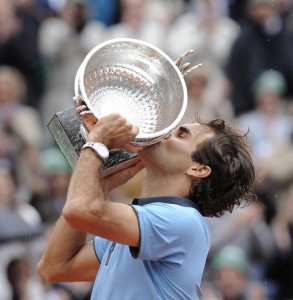
Federer wins his first French Open championship in 2009.
Finally, Federer was the favorite in Paris where he had never won.
The final was a formality with the Swiss winning 6-1, 7-6, 6-4. Federer smothered the Swede and never let him into the match. With Federer’s game in full gear and his serve clicking, Soderling never stood a chance.
It is ironic that both men Federer and Nadal found and lost their games in a reversal of tennis fortunes on the clay.
For the Mallorcan, clay was his birthright. This was where his game shone brightest and his wins were most glorious. In 2009, it proved to be where his legs gave out and where he suffered his most ignominious defeat.
For Federer, clay was at best a frustration and an impediment to his desire to be greatest ever to play to the game. On clay, he had to get by the Master who constantly blocked his path to capture that one jewel missing from his crown.
In 2009, clay proved to be Federer’s salvation, as he won the French Open. This gave him a career grand slam and allowed him to tie Pete Sampras with 14 grand slam singles titles.
As 2010 unfolds, it is remarkable that both men are harkening again to the clay to save their respective tennis fortunes. Time will tell who the clay Gods will reward this year.


